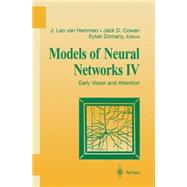- ISBN: 9780387951058 | 0387951059
- Cover: Hardcover
- Copyright: 1/1/2002
With no effort we scan a scene by directing our gaze at specific objects, discerning them individually despite the background of other objects, contours, shadows, and changes in illumination. The process is partially intentional, partially automatic, and entirely amazing: no machine can accomplish this, but the simplest insect can. A single glance captures megabytes of data; we reduce this flood by singling out specific objects for attention. This volume, with chapters by leading researchers in the field, is devoted to early vision and attention, that is, to the first stages of visual information processing.John Hertz, who has extensive experience in both computational and experimental neuroscience, provides a theoretical introduction to neural modeling. John Van Opstal explains how the gaze is controlled and presents a novel theory incorporating recent experimental results. Klaus Funke and his colleagues describe the anatomy, physiology, functional relations, and ensuing response properties of the first stages in visual information processing; they provide one of the most comprehensive reviews available at the moment. Reinhard Eckhorn explains the underlying principles of scene segmentation. Esther Peterhans and her coworkers analyze a model of figure-ground segregation and brightness perception at illusory contours. Ernst Niebur and his collaborators indicate how visual attention can be controlled; Julian Eggert and Leo van Hemmen elucidate the feedback mechanism proper. Rob de Ruyter van Steveninck and Bill Bialek show how insects process visual information with impressive efficiency. Finally, Wolfgang Maass describes paradigms for computing with spiking neurons from the point of view of a computer scientist.







